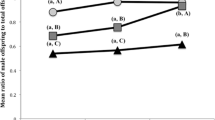Summary
Genetic heterogeneity in populations of D. melanogaster has been described for resistance to long-term exposure to CO2 (4 to 5 hours). Crosses between inbred strains, and between strains set up from single inseminated females collected in the wild show the importance of additive genes. Genetic activity for resistance and sensitivity was found on the X, 2 and 3 chromosomes.
The mechanism of resistance was shown to be an anoxia effect since the effect of an N2 atmosphere was the same as that of CO2. A study of 18 strains collected in the wild revealed a positive correlation between metabolic rate as measured by O2 uptake and mortality under CO2, and negative correlations were found between body weight, and both mortality under CO2 and metabolic rate. These results are consistent with an anoxia effect. A further variable correlated with body weight is resistance to desiccation. Thus the anoxia effect is correlated with factors determining the distribution of the species in the wild.
Similar content being viewed by others
Literature
Brooks, M. A.: The effects of repeated anaesthesia on the biology of Blattela germanica (L.). Entomol. Exp. and Appl. 8, 39–48 (1965).
Crow, J. F.: Analysis of a D.D.T.-resistant strain of Drosophila. J. Econ. Entomol. 47, 393–398 (1954).
Crow, J. F.: Genetics of insect resistance to chemicals. Ann. Rev. Entomol. 2, 227–246 (1957).
Deery, B. J., Parsons, P. A.: Variations in the resistance of natural populations of Drosophila to phenylthiocarbamide. Egypt. J. Genet. Cytol. 1, 13–17 (1972a).
Deery, B. J., Parsons, P. A.: Ether resistance in Drosophila melanogaster. Theoret. Appl. Genet. 42, 208–214 (1972b).
Edwards, L. J., Patton, R. L.: Effects of CO2 anaesthesia on the house cricket Acheta domesticus. Ann. Entomol. Soc. Amer. 58, 828–832 (1965).
Gilmour, D.: The Biochemistry of Insects. New York and London: Academic Press 1965.
Griffing, B.: Concept of general and specific combining ability in relation to diallel crossing systems. Aust. J. biol. Sci. 9, 463–493 (1956).
Hunter, A. S.: Effects of temperature on Drosophila. I. Respiration of D. melanogaster grown at different temperatures. Comp. Biochem. Physiol. 11, 411–417 (1964).
Kalmus, H., Kerridge, J., Tattersfield, F.: Occurrence of susceptibility to carbon dioxide in Drosophila melanogaster from different countries. Nature 173, 1101–1102 (1954).
Kearsey, M. J., Kojima, K.: The genetic architecture of body weight and egg hatchability in Drosophila melanogaster. Genetics 56, 23–37 (1967).
King, J. C., Sømme, L.: Chromosomal analyses of the genetic factors for resistance to D.D.T. in two resistant lines of Drosophila melanogaster. Genetics 43, 577–593 (1958).
L'Héritier, P.: The CO2 sensitivity problem in Drosophila. Cold Spring Harb. Symp. Quant. Biol. 16, 99–112 (1951).
L'Héritier, P.: The hereditary virus of Drosophila. Adv. Virus Res. 5, 195–245 (1957).
L'Héritier, Teissier, G.: Une anomalie physiologique héréditaire chez le Drosophile. C. R. hebd. Séanc. Acad. Sci. Paris 205, 1099–1101 (1937).
Lints, F. A., Lints, C. V.: Respiration in Drosophila. III. Influence of preimaginal environment on respiration and ageing in Drosophila melanogaster hybrids. Exp. Geront. 4, 81–94 (1969).
Mather, K.: The balance of polygenic combinations. J. Genet. 43, 309–336 (1942).
Mather, K.: Polygenic inheritance and natural selection. Biol. Rev. 18, 32–64 (1943).
Mather, K.: Variability and selection. Proc. Roy. Soc. London B. 164, 328–340 (1966).
Matheson, A. C., Arnold, J. T. A.: Resistance to Carbon Dioxide, an anoxic stress in Drosophila melanogaster. Experientia, in press (1973).
Parsons, P. A.: The genotypic control of longevity in Drosophila melanogaster under two environmental regimes. Aust. J. Biol. Sci. 19, 587–591 (1966).
Parsons, P. A.: Genetic heterogeneity in natural populations of Drosophila melanogaster for ability to withstand desiccation. Theoret. and Appl. Genetics 40, 261–266 (1970).
Parsons, P. A.: Behavioural and Ecological Genetics. A Study in Drosophila. Oxford: Clarendon Press 1973.
Parsons, P. A., Hosgood, S. M. W., Lee, B. T. O.: Polygenes and polymorphism. Molec. Gen. Genetics 99, 165–170 (1967).
Parsons, P.A., MacBean, I. T., Lee, B. T. O.: Polymorphism in natural populations for genes controlling radioresistance in Drosophila. Genetics 61, 211–218 (1969).
Prosser, C. L., Brown, F. A.: Comparative Animal Physiology, 2nd ed. Philadelphia: W. B. Saunders 1961.
Thoday, J. M., Gibson, J. B., Spickett, S. G.: Some polygenes. Heredity 18, 553–554 (1963).
Umbreit, W. W., Burris, R. H., Stauffer, J. F.: Manometric Techniques, 4th ed. Minneapolis: Burgess 1964.
Westerman, J. M., Parsons, P.A.: Variations in genetic architecture at different doses of γ-radiation as measured by longevity in Drosophila melanogaster. Canad. J. Genet. Cytol., in press (1973).
Williamson, D. L.: Carbon dioxide sensitivity in Drosophila affinis and Drosophila athabasca. Genetics 46, 1053–1060 (1961).
Author information
Authors and Affiliations
Additional information
Communicated by G. Melchers and W. Seyffert
Rights and permissions
About this article
Cite this article
Matheson, A.C., Parsons, P.A. The genetics of resistance to long-term exposure to CO2 in Drosophila melanogaster; an environmental stress leading to anoxia. Theoret. Appl. Genetics 43, 261–268 (1973). https://doi.org/10.1007/BF00277786
Received:
Issue Date:
DOI: https://doi.org/10.1007/BF00277786




